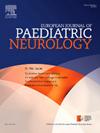心血管反应作为脑损伤儿童神经功能障碍预测因子的作用-一项初步研究
IF 2.3
3区 医学
Q3 CLINICAL NEUROLOGY
引用次数: 0
摘要
目的:我们旨在评估严重急性脑损伤(ABI)儿童的中长期神经预后,并确定与不良预后相关的心血管预测因素,如心率(HR)、血压(BP)和心率变异性(HRV)。HRV是指连续心跳之间的振荡,反映了心脏交感神经和副交感神经冲动之间的动态相互作用。它提供了自主神经系统(ANS)活动的非侵入性指标。前瞻性观察队列。三级学术儿科重症监护病房(PICU)。患者:儿童27天,18岁,严重ABI后入住PICU,存活至PICU出院。排除PICU入院时怀疑脑死亡或有心律失常的儿童。干预措施:测量:在PICU入院后的最初12小时内收集生理变量、神经学数据、化学和血液学检查以及药物。通过心电图(ECG)动态心电图记录、计算机断层扫描(CT)和PICU评分获得HRV的线性和非线性指标,以及PICU内的生存率进行评估。主要结局指标是损伤后3个月和12个月用儿科格拉斯哥结局量表(GOSE-Peds)测量的整体功能结局。这些数据是通过查阅医疗记录得来的。结果根据预先确定的截止点分为有利和不利两类。无至轻度残疾(GOSE-E PEDS分类≤2)被归类为有利结果,而中度至重度残疾被归类为不利结果(GOSE-E PEDS分类≥3)。31例ABI患儿符合研究条件。男性24例(77.4%),中位年龄11.3岁(IQR 5.6 ~ 14.3)。外伤性脑损伤22例(71.0%),脑出血5例(16.1%)。16例患儿(51.6%)在3个月时预后良好,21例患儿(67.7%)在12个月时预后良好。心动过速或心动过缓与预后无关。收缩压(SBP)在PICU入院后12小时内高于95百分位的患者在3个月时表现出明显更好的神经系统预后[15(68.2%)比9 (31.8%),p = 0.006], 12个月时[20(83.3%)比4 (16.7%),p = 0.002]。在3个月和12个月预后良好的患者,入院时和入院后12小时计算的HRV值均较高。然而,这些结果仅在RMSSD、LF、TP和poincarcars入院后12小时的SD1和SD2以及入院后3个月的结果中具有统计学意义。LF >患者;入院后12小时70.0 ms2的患者在12个月时的预后明显更好[11.0 (91.7%)vs 1.0 (8.3%), p = 0.046]。入院后12小时,87.5%的SDNN >;35.0 ms患者和70.5%的RMSSD >;3.2 ms患者在3个月时的预后有统计学意义。预后不良的患者需要更多的机械通气时间,在PICU的住院时间(LOS)也更长。结论:本研究表明,早期收缩压和HRV指数升高,特别是PICU入院后12小时测量的LF功率,可能是严重ABI患儿长期神经预后的独立、无创预测指标。这些发现支持了早期自主神经激活作为预后良好标志的作用,并强调了将心血管和自主神经监测纳入预后模型和个性化神经保护策略的潜在价值。本文章由计算机程序翻译,如有差异,请以英文原文为准。
The role of cardiovascular response as a predictor of neurologic disability in children with brain injury – a pilot study
Objective
We aimed to assess medium-to long-term neurological outcomes in children with severe acute brain injury (ABI) and to identify cardiovascular predictors associated with unfavorable outcomes, such as heart rate (HR), blood pressure (BP), and heart rate variability (HRV). HRV refers to the oscillations in the intervals between consecutive heartbeats, reflecting the dynamic interplay between sympathetic and parasympathetic impulses to the heart. It provides a non-invasive indicator of autonomic nervous system (ANS) activity.
Design
Prospective observational cohort.
Setting
Tertiary academic pediatric intensive care unit (PICU).
Patients
Children >27 days and <18 years old admitted to the PICU after severe ABI who survived to PICU discharge. Children suspected of being brain dead at PICU admission or with cardiac arrythmias were excluded.
Interventions
None.
Measure
ments: Physiological variables, neurological data, chemistry and hematologic tests and medication were collected within the initial 12 h following admission to the PICU. Linear and nonlinear indices of HRV obtained from electrocardiogram (ECG) Holter recordings, computerized tomography (CT) and PICU scores, as well as survival rates within the PICU, were evaluated. The primary outcome measure was global functional outcome as measured by the Pediatrics Glasgow Outcome Scale Extended (GOSE-Peds) at 3 and 12 months after injury. These data were taken by reviewing the medical records. The outcome was dichotomized into favorable and unfavorable based on predefined cutoffs. None to mild disability (GOSE-E PEDS category ≤2) was categorized as favorable outcome, whereas moderate to severe disability was categorized as unfavorable (GOSE-E PEDS category ≥3).
Main results
Thirty-one children with ABI were eligible for the study. Twenty-four were male (77.4 %) and they had the median age of 11.3 years old (IQR 5.6–14.3). Twenty-two (71.0 %) patients had traumatic brain injury (TBI) and five (16.1 %) cerebral hemorrhage. Sixteen children (51.6 %) had a favorable outcome at 3 months and twenty-one (67.7 %) at 12 months. The presence of tachycardia or bradycardia was not related to the prognosis. Patients with systolic arterial blood pressure (SBP) above the 95th percentile in the first 12 h after admission to the PICU exhibited a significantly better neurological outcome [15 (68.2 %) vs. 9 (31.8 %), p = 0.006] at 3 months, and [20 (83.3 %) vs. 4 (16.7 %), p = 0.002] at 12 months. Calculated HRV values were higher, both on admission and 12 h after admission, in patients with a favorable prognosis at 3 and 12 months. However, these results were statistically significant only for RMSSD, LF, TP, and Poincaré SD1 and SD2 at 12 h after admission and for outcomes at 3 months. Patients with LF > 70.0 ms2 at 12 h after admission had a significantly better outcome at 12 months [11.0 (91.7 %) vs 1.0 (8.3 %), p = 0.046]. 87.5 % of patients with SDNN >35.0 ms and 70.5 % of patients with RMSSD >3.2 ms, at 12 h after admission, showed a statistically significative better outcome at 3 months. Patients who had a more unfavorable prognosis spent significantly more time on mechanical ventilation and had a longer length of stay (LOS) in the PICU.
Conclusions
This study suggests that elevated early SBP and HRV indices—particularly LF power measured 12 h after PICU admission—may serve as independent, non-invasive predictors of long-term neurological outcomes in children with severe ABI. These findings support the role of early autonomic activation as a marker of favorable prognosis and underscore the potential value of incorporating cardiovascular and autonomic monitoring into prognostic models and individualized neuroprotective strategies in pediatric neurocritical care.
求助全文
通过发布文献求助,成功后即可免费获取论文全文。
去求助
来源期刊
CiteScore
6.30
自引率
3.20%
发文量
115
审稿时长
81 days
期刊介绍:
The European Journal of Paediatric Neurology is the Official Journal of the European Paediatric Neurology Society, successor to the long-established European Federation of Child Neurology Societies.
Under the guidance of a prestigious International editorial board, this multi-disciplinary journal publishes exciting clinical and experimental research in this rapidly expanding field. High quality papers written by leading experts encompass all the major diseases including epilepsy, movement disorders, neuromuscular disorders, neurodegenerative disorders and intellectual disability.
Other exciting highlights include articles on brain imaging and neonatal neurology, and the publication of regularly updated tables relating to the main groups of disorders.

 求助内容:
求助内容: 应助结果提醒方式:
应助结果提醒方式:


